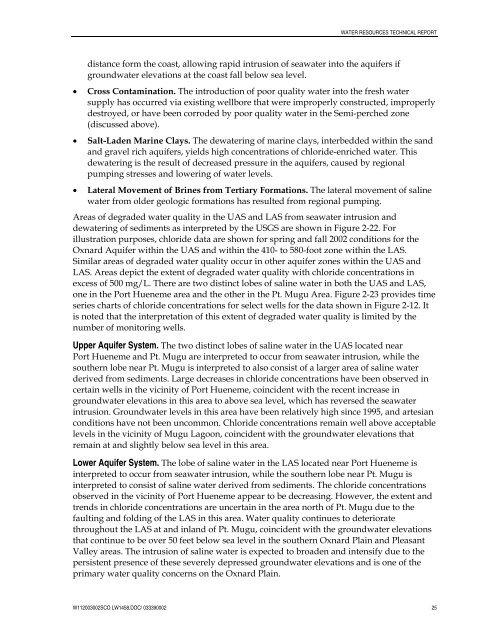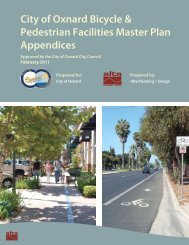View File - Development Services - City of Oxnard
View File - Development Services - City of Oxnard
View File - Development Services - City of Oxnard
You also want an ePaper? Increase the reach of your titles
YUMPU automatically turns print PDFs into web optimized ePapers that Google loves.
WATER RESOURCES TECHNICAL REPORTdistance form the coast, allowing rapid intrusion <strong>of</strong> seawater into the aquifers ifgroundwater elevations at the coast fall below sea level.• Cross Contamination. The introduction <strong>of</strong> poor quality water into the fresh watersupply has occurred via existing wellbore that were improperly constructed, improperlydestroyed, or have been corroded by poor quality water in the Semi-perched zone(discussed above).• Salt-Laden Marine Clays. The dewatering <strong>of</strong> marine clays, interbedded within the sandand gravel rich aquifers, yields high concentrations <strong>of</strong> chloride-enriched water. Thisdewatering is the result <strong>of</strong> decreased pressure in the aquifers, caused by regionalpumping stresses and lowering <strong>of</strong> water levels.• Lateral Movement <strong>of</strong> Brines from Tertiary Formations. The lateral movement <strong>of</strong> salinewater from older geologic formations has resulted from regional pumping.Areas <strong>of</strong> degraded water quality in the UAS and LAS from seawater intrusion anddewatering <strong>of</strong> sediments as interpreted by the USGS are shown in Figure 2-22. Forillustration purposes, chloride data are shown for spring and fall 2002 conditions for the<strong>Oxnard</strong> Aquifer within the UAS and within the 410- to 580-foot zone within the LAS.Similar areas <strong>of</strong> degraded water quality occur in other aquifer zones within the UAS andLAS. Areas depict the extent <strong>of</strong> degraded water quality with chloride concentrations inexcess <strong>of</strong> 500 mg/L. There are two distinct lobes <strong>of</strong> saline water in both the UAS and LAS,one in the Port Hueneme area and the other in the Pt. Mugu Area. Figure 2-23 provides timeseries charts <strong>of</strong> chloride concentrations for select wells for the data shown in Figure 2-12. Itis noted that the interpretation <strong>of</strong> this extent <strong>of</strong> degraded water quality is limited by thenumber <strong>of</strong> monitoring wells.Upper Aquifer System. The two distinct lobes <strong>of</strong> saline water in the UAS located nearPort Hueneme and Pt. Mugu are interpreted to occur from seawater intrusion, while thesouthern lobe near Pt. Mugu is interpreted to also consist <strong>of</strong> a larger area <strong>of</strong> saline waterderived from sediments. Large decreases in chloride concentrations have been observed incertain wells in the vicinity <strong>of</strong> Port Hueneme, coincident with the recent increase ingroundwater elevations in this area to above sea level, which has reversed the seawaterintrusion. Groundwater levels in this area have been relatively high since 1995, and artesianconditions have not been uncommon. Chloride concentrations remain well above acceptablelevels in the vicinity <strong>of</strong> Mugu Lagoon, coincident with the groundwater elevations thatremain at and slightly below sea level in this area.Lower Aquifer System. The lobe <strong>of</strong> saline water in the LAS located near Port Hueneme isinterpreted to occur from seawater intrusion, while the southern lobe near Pt. Mugu isinterpreted to consist <strong>of</strong> saline water derived from sediments. The chloride concentrationsobserved in the vicinity <strong>of</strong> Port Hueneme appear to be decreasing. However, the extent andtrends in chloride concentrations are uncertain in the area north <strong>of</strong> Pt. Mugu due to thefaulting and folding <strong>of</strong> the LAS in this area. Water quality continues to deterioratethroughout the LAS at and inland <strong>of</strong> Pt. Mugu, coincident with the groundwater elevationsthat continue to be over 50 feet below sea level in the southern <strong>Oxnard</strong> Plain and PleasantValley areas. The intrusion <strong>of</strong> saline water is expected to broaden and intensify due to thepersistent presence <strong>of</strong> these severely depressed groundwater elevations and is one <strong>of</strong> theprimary water quality concerns on the <strong>Oxnard</strong> Plain.W112003002SCO LW1458.DOC/ 033390002 25
















